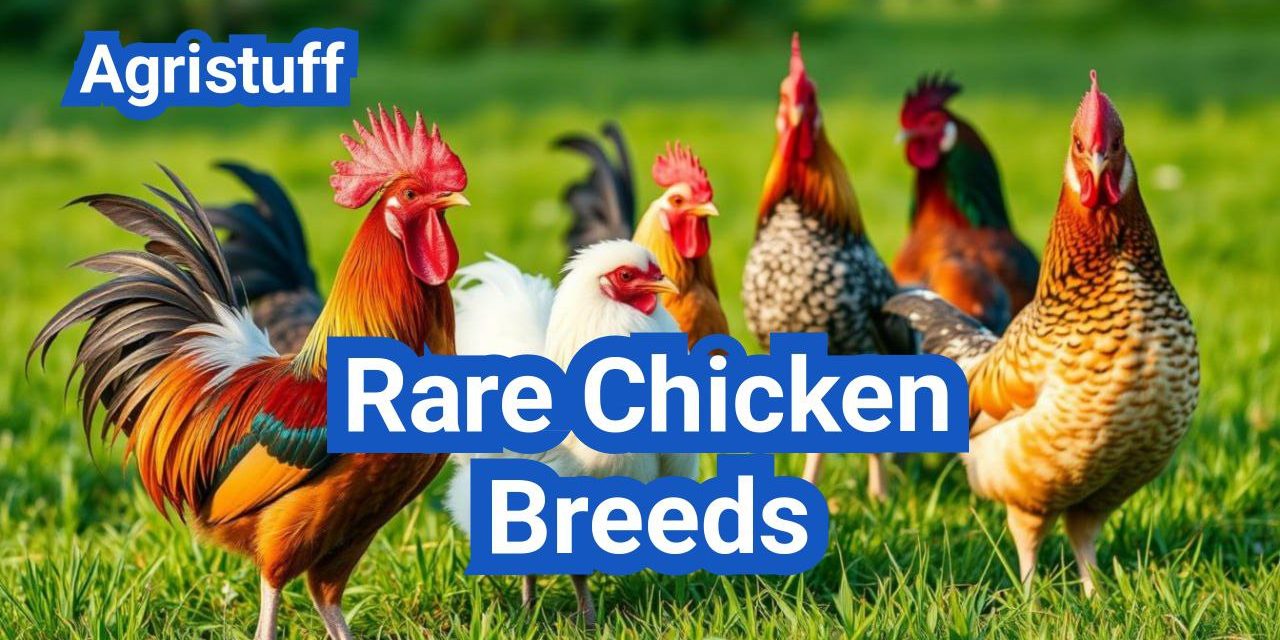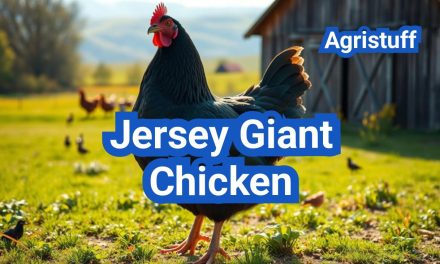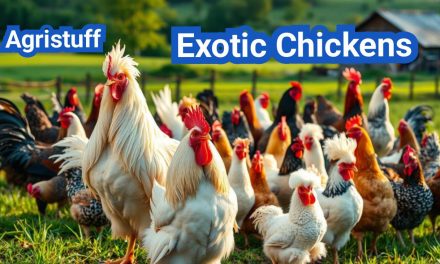The world of rare chicken breeds is a treasure trove of unique characteristics, history, and cultural significance. With fewer than 500 breeding individuals in the United States and a worldwide population of under 1,000 birds, a chicken breed is considered rare according to The Livestock Conservancy.
From the completely black Ayam Cemani to the elegant Polish chickens, these heritage chicken breeds offer a glimpse into the diversity of poultry. The Sicilian Buttercup chicken is another example of a conservation poultry breed that is worth preserving.
Key Takeaways
- Rare chicken breeds have unique characteristics and cultural significance.
- The Livestock Conservancy considers a breed rare if it has fewer than 500 breeding individuals in the US.
- Ayam Cemani and Polish chickens are examples of rare breeds.
- Conservation efforts are necessary to preserve these heritage breeds.
- Rare chicken breeds offer a glimpse into the diversity of poultry.
What Makes a Chicken Breed Rare
Understanding what makes a chicken breed rare involves examining the breed’s conservation status and its genetic uniqueness. The classification of chicken breeds into different conservation categories is crucial for identifying and protecting rare breeds.
Definition and Classification Criteria
A chicken breed is considered rare based on its population size and global distribution. The Livestock Conservancy, a leading organization in poultry conservation, considers a breed ‘critical’ when there are fewer than 500 breeding individuals in the US and fewer than 1,000 worldwide. This classification highlights the urgent need for conservation efforts to protect these breeds from extinction.
The conservation status of chicken breeds is typically categorized based on their population size. The following table illustrates the conservation status categories used by the Livestock Conservancy:
| Conservation Status | US Population | Global Population |
|---|---|---|
| Critical | <500 | <1,000 |
| Threatened | 500-1,000 | 1,000-2,000 |
| Watch | 1,000-5,000 | 2,000-5,000 |
| Recovering | >5,000 | >5,000 (previously listed) |
Heritage vs. Rare: Understanding the Distinction
While often used interchangeably, the terms “heritage” and “rare” have distinct meanings in the context of chicken breeds. Heritage breeds are traditional breeds that have been developed over time through careful selection and breeding practices. They are often associated with historical and cultural significance. In contrast, rare breeds are specifically those that are at risk due to their low population numbers.
Heritage breeds may not always be rare, as some have relatively large populations. Conversely, a rare breed is not necessarily a heritage breed, although many rare breeds are indeed heritage breeds. Understanding this distinction is crucial for conservation efforts, as it allows breeders and conservationists to target their efforts effectively.
The Importance of Genetic Diversity in Poultry
Genetic diversity is vital for the long-term survival and adaptability of chicken breeds. A diverse gene pool enables breeds to adapt to changing environments, resist diseases, and maintain productivity. Rare breeds, in particular, often possess unique genetic traits that are worth preserving.
Conserving genetic diversity in poultry involves maintaining a wide range of breeds and ensuring that breeding programs avoid inbreeding. This not only helps in preserving rare breeds but also contributes to the overall health and resilience of poultry populations worldwide.
The World of Rare Chicken Breeds

Rare chicken breeds are more than just unusual animals; they are keepers of heritage and history. These breeds have been preserved over centuries, often due to their unique characteristics, historical significance, or cultural importance.
Historical Significance and Cultural Heritage
Rare chicken breeds like the Ayam Cemani and the Scots Dumpy are not just remarkable for their appearance but also for the historical and cultural significance they carry. The Ayam Cemani, originating from Indonesia, is known for its entirely black features, including its feathers, beak, and internal organs. This breed is considered a symbol of good luck and prosperity.
The Scots Dumpy, on the other hand, is a heritage breed from Scotland, known for its short legs. It has been a part of Scottish agricultural history for centuries. Such breeds are invaluable in understanding our agricultural past and the evolution of poultry.
Conservation Efforts
Many rare breeds are now the focus of conservation efforts due to their dwindling populations. Organizations around the world are working to preserve these breeds, not just for their historical significance but also for the genetic diversity they bring to the world of poultry.
Conservation Status Categories
The conservation status of chicken breeds is categorized based on their population size and the risk of extinction. Breeds are classified as critical, endangered, or watchlist, depending on their numbers. The Food and Agriculture Organization (FAO) of the United Nations maintains a global database on the status of poultry breeds.
| Conservation Status | Description | Example Breeds |
|---|---|---|
| Critical | High risk of extinction; very low population | Ayam Cemani, Scots Dumpy |
| Endangered | Significant risk of extinction; low population | Chantecler, Faverolles |
| Watchlist | Monitored due to declining numbers | Jersey Giant, Brahma |
Benefits of Raising Uncommon Breeds
Raising rare chicken breeds can be highly rewarding. Not only do these breeds offer unique characteristics, but they also contribute to genetic diversity within the poultry world. Additionally, they can be a valuable addition to a farm or backyard flock, providing a connection to historical and cultural heritage.
- Genetic diversity
- Unique characteristics
- Cultural and historical significance
- Potential for specialty eggs or meat production
By incorporating rare breeds into a flock, poultry enthusiasts can help ensure the survival of these unique animals while also benefiting from their distinct qualities.
Ayam Cemani: The Extraordinary Black Chicken
The Ayam Cemani, known for its striking black features, is a rare chicken breed that has garnered significant attention worldwide. This breed, originating from Indonesia, is not just a curiosity among poultry enthusiasts but also a subject of interest due to its unique genetic condition.
Origins and History
The Ayam Cemani, which translates to “black chicken” in Indonesian, has a rich history that dates back centuries. This breed is believed to have originated in the islands of Java and Sumatra, where it was considered a sacred bird due to its mystical appearance. The Ayam Cemani was introduced to Europe and other parts of the world in the early 20th century, captivating breeders with its unique features.
Distinctive Features and Fibromelanosis
The Ayam Cemani is characterized by its entirely black coloration, including its feathers, beak, tongue, and internal organs. This is due to a genetic condition known as fibromelanosis, which results in an excessive production of melanin. This condition is rare and gives the Ayam Cemani its distinctive appearance, making it a prized breed among poultry enthusiasts.
The breed’s fibromelanosis is not just a cosmetic trait; it is a result of a complex genetic makeup that requires careful breeding practices to maintain. The condition affects not just the bird’s appearance but also its health and vitality, making it crucial for breeders to monitor the genetic diversity of their flock.
Breeding Challenges and Considerations
Breeding Ayam Cemani chickens poses several challenges. The genetic condition that causes their black coloration can also lead to health issues if not managed properly. Breeders must carefully select breeding pairs to ensure the health and genetic diversity of the offspring. Additionally, the breed’s rarity means that there is a limited gene pool, further complicating breeding efforts.
- Selecting healthy breeding pairs with diverse genetic backgrounds
- Monitoring the health of chicks and adults for signs of genetic disorders
- Maintaining detailed records of breeding and health issues
Price Points and Investment Value
Ayam Cemani chickens are highly valued due to their rarity and unique appearance. As a result, they can command high prices, especially for birds with pure lineage and those that have been bred according to strict standards. For serious breeders and collectors, the Ayam Cemani represents not just a pet or a hobby but also a significant investment.
The value of Ayam Cemani chickens can vary widely based on factors such as their lineage, health, and breeding potential. As with any rare breed, the market demand and the availability of these birds play a crucial role in determining their price.
Rare Chicken Breeds in America

From the heritage breeds of Native American communities to endangered species, the US hosts a variety of rare chicken breeds. These breeds are not only significant for their historical and cultural value but also for their unique characteristics that contribute to the genetic diversity of poultry.
Native American Heritage Breeds
Native American communities have long been keepers of unique and rare chicken breeds. Breeds such as the Erminette, known for its striking plumage, are examples of the rich poultry heritage found among Native American tribes. These breeds have been preserved through generations and are an integral part of the cultural identity of their communities.
Endangered Chicken Breeds in the USA
The US is home to several chicken breeds that are considered endangered. The Holland breed, for instance, is a rare breed known for its white eggs and friendly disposition. Conservation efforts are crucial to protect these breeds from extinction and to preserve the genetic material they represent.
American Poultry Association Recognition Process
The American Poultry Association (APA) plays a significant role in the recognition and conservation of rare chicken breeds. The APA has a formal process for recognizing new breeds, which involves breeders submitting their breeds for evaluation based on specific criteria, including breed characteristics, egg production, and temperament.
Regional Conservation Programs
Across the US, regional conservation programs are working to protect and promote rare chicken breeds. These programs often involve collaboration between breeders, conservation organizations, and agricultural extension services. They provide resources and support to breeders, including breeding stock, technical advice, and marketing assistance, to help conserve these valuable genetic resources.
International Rare Chicken Breeds
From the UK to Canada, rare chicken breeds are cherished by poultry enthusiasts worldwide. These unique breeds not only add diversity to backyard flocks but also play a crucial role in preserving genetic heritage.
Rare Chicken Breeds in the UK
The UK is home to a variety of rare chicken breeds, many of which are recognized and protected by the Rare Breeds Survival Trust (RBST). Some notable examples include:
- The Derbyshire Redcap, known for its distinctive rose comb and rich history.
- The Norfolk Black, a hardy and friendly breed.
- The Sussex, a popular choice for its egg-laying capabilities.
According to the RBST, these breeds are not only valuable for their genetic uniqueness but also for their contribution to the country’s agricultural heritage.
| Breed | Origin | Status |
|---|---|---|
| Derbyshire Redcap | UK | At Risk |
| Norfolk Black | UK | Critical |
| Sussex | UK | Vulnerable |
Rare Chicken Breeds in Australia
Australia has its own set of rare chicken breeds, often characterized by their adaptability to the country’s diverse climates. The Australian Poultry Association recognizes several breeds, including:
- The Australian Langshan, known for its egg-laying and meat production.
- The White Sussex, a popular choice for its hardiness.
A notable figure in Australian poultry is the Hawkesbury Heritage breed, which is celebrated for its unique characteristics.
Rare Chicken Breeds in New Zealand
New Zealand is home to a range of rare chicken breeds, many of which are prized for their foraging abilities and hardiness. Some examples include:
- The New Zealand X Shropshire, a cross known for its productivity.
- The Silver Grey Dorking, a heritage breed valued for its meat.
“The preservation of rare chicken breeds is crucial for maintaining biodiversity in our agricultural ecosystems.” – Poultry Expert
Rare Chicken Breeds in Canada
Canada boasts a diverse range of rare chicken breeds, often reflecting the country’s cultural and agricultural heritage. Some notable breeds include:
- The Chantecler, Canada’s only heritage breed, known for its cold hardiness.
- The Quebecoise, a historic breed from Quebec.
In conclusion, rare chicken breeds around the world, including those in the UK, Australia, New Zealand, and Canada, are invaluable assets to poultry enthusiasts and the global community. Their preservation is essential for maintaining genetic diversity and cultural heritage.
Ornamental Rare Breeds with Striking Appearances

Among the many rare chicken breeds, some stand out for their ornamental value and striking looks. These breeds are not only a joy to behold but also add a unique touch to any flock. Their distinctive features and beauty make them highly sought after by poultry enthusiasts.
Polish Chickens and Their Crested Varieties
Polish chickens are renowned for their crested heads, which give them a distinctive and elegant appearance. Originating from Poland, these chickens have been bred in various colors and crest types, making them a favorite among those who appreciate ornamental poultry. Their friendly and curious nature adds to their appeal.
Sicilian Buttercup Chickens
The Sicilian Buttercup is another breed that stands out due to its striking appearance. Characterized by its golden-copper plumage and unique buttercup-shaped comb, this breed is a true showstopper. Their lively and active nature makes them a delightful addition to any backyard flock.
White-Faced Black Spanish
The White-Faced Black Spanish chicken is known for its sleek black plumage and striking white face. This breed’s elegant appearance and high egg production make it a popular choice. Their friendly disposition and relatively low maintenance requirements add to their appeal.
Appenzeller Spitzhauben and Other Exotic Breeds
Appenzeller Spitzhauben chickens are known for their striking appearance, featuring a unique spitzhauben (or “pointed hat”) crest. Originating from Switzerland, these chickens are not only visually appealing but also known for their active and foraging nature. Other exotic breeds like these add diversity and beauty to the world of ornamental poultry.
In conclusion, ornamental rare breeds like the Polish, Sicilian Buttercup, White-Faced Black Spanish, and Appenzeller Spitzhauben offer a range of striking appearances that captivate poultry enthusiasts. Their unique features and beauty make them a valuable addition to any flock.
Unusual Egg Color Breeds

Beyond the typical brown or white eggs, certain breeds produce eggs in a variety of colors that fascinate and delight. These unusual egg color breeds are not only a joy to keep but also offer a unique selling point for those looking to market their eggs.
Olive Eggers and Green Egg Layers
Olive Eggers are a cross between a breed that lays dark brown eggs, like the Marans, and a breed that lays blue eggs, such as the Araucana. This results in a chicken that lays eggs with a beautiful olive green color. The unique egg color is due to the genetic combination of the parent breeds.
Olive Eggers are gaining popularity for their striking egg color and friendly disposition. They are a great choice for backyard chicken keepers looking for something different.
Marans and Chocolate Egg Layers
The Marans breed is renowned for its dark, chocolate-brown eggs. The eggs are so dark they often appear almost black. Marans are a French breed that has gained international recognition for their egg-laying abilities and rich egg color.
Marans eggs are highly prized by chefs and bakers for their rich color and are often used to add a unique touch to baked goods and desserts.
Blue Egg Layers: Araucana and Ameraucana
The Araucana and Ameraucana breeds are known for their ability to lay blue eggs. This unique trait is the result of a genetic mutation that causes the eggshell to be blue. Both breeds are popular among chicken enthusiasts for their egg-laying abilities and friendly nature.
Araucanas and Ameraucanas are also known for their lack of tails and tufted faces, making them a visually appealing addition to any backyard flock.
Marketing Specialty Colored Eggs
Specialty colored eggs, such as those laid by Olive Eggers, Marans, and Araucanas, can command a higher price at market due to their unique appearance. Chicken keepers can capitalize on the trend towards artisanal and unique food products by marketing these eggs directly to consumers.
As consumers become more interested in the origin and characteristics of their food, the demand for specialty colored eggs is likely to grow. Chicken keepers who can supply these eggs consistently and of high quality will be well-positioned to take advantage of this trend.
As quoted by a well-known poultry expert, “The unique characteristics of these breeds not only make for interesting backyard flocks but also offer opportunities for entrepreneurs in the poultry industry.”
“The genetic diversity that allows for such a wide range of egg colors is a treasure trove for chicken enthusiasts and breeders alike.”
Dual-Purpose Rare Chickens for Productivity

Dual-purpose chicken breeds offer the unique advantage of providing both eggs and meat, making them a valuable addition to any flock. These breeds are particularly appealing to poultry enthusiasts who seek to maximize their farm’s productivity without compromising on the quality of either eggs or meat.
Bresse Gauloise: The Queen of Table Birds
The Bresse Gauloise is renowned for its exceptional meat quality and is often referred to as “the queen of table birds.” Originating from France, this breed is prized for its tender and flavorful meat. While it’s primarily raised for meat, it also lays a respectable number of eggs, making it a true dual-purpose breed.
Chantecler: Canada’s Heritage Breed
The Chantecler is a Canadian heritage breed known for its cold hardiness and egg-laying abilities. It’s a versatile breed that provides both a substantial number of eggs and quality meat, making it an excellent choice for those looking for a dual-purpose bird.
Faverolles: Beauty and Utility Combined
Faverolles chickens are not only known for their striking appearance but also for their utility. They lay a significant number of eggs and have a meaty carcass, making them suitable for both egg production and meat.
Jersey Giants and Other Large Heritage Breeds
Jersey Giants are among the largest chicken breeds and are valued for their meat production. While they lay fewer eggs compared to some other breeds, their size and meat quality make them an attractive option for those looking to raise chickens for both eggs and meat.
| Breed | Egg Production | Meat Quality |
|---|---|---|
| Bresse Gauloise | Moderate | Excellent |
| Chantecler | High | Good |
| Faverolles | High | Good |
| Jersey Giants | Moderate | Excellent |
In conclusion, dual-purpose chicken breeds like the Bresse Gauloise, Chantecler, Faverolles, and Jersey Giants offer a practical solution for poultry enthusiasts. They provide a balance between egg production and meat quality, making them invaluable for those seeking to diversify their poultry’s output.
How to Select the Right Rare Breed for Your Flock

Selecting the ideal rare chicken breed for your backyard flock requires careful consideration of several key factors. With numerous breeds to choose from, each with its unique characteristics, making an informed decision is crucial for the well-being of both your new and existing flock members.
Climate and Environment Compatibility
The first step in choosing a rare breed is to assess your local climate and environment. Some breeds are more tolerant of cold or heat than others. For instance, breeds originating from colder climates, such as the Chantecler, are well-suited for areas with harsh winters. Conversely, breeds like the Ayam Cemani, with origins in tropical regions, may require extra care in colder climates.
Space and Housing Requirements
The amount of space available for your flock is another critical factor. Larger breeds or those with high energy levels, such as the Jersey Giant, require more space to roam. Ensuring that your coop and run are adequately sized for your chosen breed is essential for their health and happiness.
- Consider the size of your coop and run.
- Assess the energy level of the breed.
- Plan for adequate space to prevent overcrowding.
Temperament and Flock Integration
The temperament of the rare breed you choose should be compatible with your existing flock, if you have one. Some breeds are more docile and integrate well, while others may be more aggressive or skittish. Introducing new birds to your flock should be done carefully to prevent stress and conflict.
Researching the breed’s temperament and understanding the dynamics of your current flock are vital steps in ensuring a harmonious integration.
Aligning Breeds with Your Poultry Goals
Finally, your choice of rare breed should align with your poultry goals. Whether you’re interested in egg production, meat, or simply the joy of raising unique birds, there’s a breed that fits your needs. For example, if you’re looking for a dual-purpose breed, the Faverolles might be an excellent choice due to their egg-laying abilities and meat quality.
By carefully considering these factors, you can select a rare chicken breed that not only thrives in your care but also enhances your poultry-keeping experience.
Finding and Purchasing Rare Chicken Breeds
The quest for rare chicken breeds often begins with identifying trustworthy hatcheries and breeders. With the rise in popularity of backyard poultry keeping, the demand for unique and rare breeds has increased, making it essential for enthusiasts to know where to look.
Reputable Rare Breed Hatcheries in the US
Several hatcheries across the United States specialize in rare and exotic chicken breeds. These hatcheries not only provide high-quality birds but also offer valuable resources and guidance for new breeders. Some well-known hatcheries include:
- Meyer Hatchery
- Stromberg’s Chicks
- Hatchery Choice
When selecting a hatchery, it’s crucial to research their reputation, breeding practices, and customer reviews to ensure you’re getting healthy, purebred birds.
Evaluating Hatching Eggs vs. Chicks vs. Adult Birds
When purchasing rare chicken breeds, enthusiasts have the option to buy hatching eggs, chicks, or adult birds. Each option has its pros and cons:
| Option | Pros | Cons |
|---|---|---|
| Hatching Eggs | Cost-effective, allows for incubation experience | Requires incubation equipment, hatch rate variability |
| Chicks | Easier to start than eggs, immediate results | More expensive than eggs, still requires brooding |
| Adult Birds | Immediate egg production or breeding capability | Most expensive option, potential for health or temperament issues |
As noted by poultry expert, “The choice between hatching eggs, chicks, and adult birds depends on the breeder’s experience, resources, and goals.” (
“Breeding rare poultry requires patience, knowledge, and the right equipment. Starting with the right stock is crucial for success.”
–
Dr. Jane Smith, Poultry Breeder
)
Networking at Poultry Shows and Auctions
Poultry shows and auctions are excellent venues for networking with other breeders and finding rare chicken breeds. These events provide opportunities to see birds in person, learn about new breeds, and connect with reputable breeders.
Understanding Import Regulations and Quarantine
For those interested in acquiring rare breeds from international sources, understanding import regulations and quarantine procedures is vital. Regulations vary by country and state, so thorough research is necessary to comply with all requirements and ensure the health and safety of your flock.
By following these guidelines and being mindful of the challenges involved, enthusiasts can successfully find and purchase rare chicken breeds, contributing to the preservation and promotion of these unique poultry varieties.
Specialized Care for Rare Chicken Breeds

The unique characteristics of rare chicken breeds necessitate tailored care approaches to ensure their health and well-being. Providing the right environment and care is crucial for these breeds to thrive.
Nutrition Requirements for Optimal Health
Rare chicken breeds often have specific dietary needs that must be met to maintain their health. A balanced diet rich in necessary nutrients is essential. For instance, some breeds may require more protein or specific vitamins and minerals. Ensuring access to fresh water and a varied diet can help prevent nutritional deficiencies.
Preventing Common Health Issues
Health issues in rare chicken breeds can arise from various factors, including genetics, environment, and nutrition. Regular health checks and a clean living environment are crucial in preventing diseases. Vaccinations and parasite control measures should be implemented as necessary.
Breeding Programs to Maintain Genetic Purity
Breeding programs play a vital role in maintaining the genetic purity of rare chicken breeds. These programs involve careful selection of breeding stock to preserve the breed’s characteristics. It’s essential to avoid inbreeding and ensure genetic diversity within the breed.
Record Keeping and Pedigree Management
Accurate record keeping and pedigree management are critical components of a successful breeding program. Keeping detailed records of an individual bird’s lineage, health, and production traits helps in making informed breeding decisions. This practice ensures the integrity and quality of the breed over generations.
By focusing on these aspects of care, breeders can help ensure the survival and prosperity of rare chicken breeds. Whether you’re a seasoned breeder or just starting out, understanding and implementing these specialized care practices is key to success.
Conservation Efforts for Endangered Poultry

Rare chicken breeds face numerous threats, making conservation efforts essential for their survival. The loss of genetic diversity in poultry can have significant impacts on food security, cultural heritage, and the overall health of chicken populations.
Threats to Rare Breed Survival
Rare chicken breeds are vulnerable to various threats, including habitat loss, disease, and the increasing popularity of commercial poultry breeds. These factors contribute to the decline in populations of heritage breeds, making conservation a pressing issue.
- Habitat destruction and fragmentation
- Disease outbreaks
- Competition from commercial breeds
- Lack of genetic diversity
Organizations Supporting Poultry Conservation
Several organizations are dedicated to the conservation of endangered poultry. The Livestock Conservancy is a prominent example, working tirelessly to protect and promote rare breeds through various programs and initiatives.
These organizations often collaborate with breeders, researchers, and the public to:
- Promote the importance of genetic diversity
- Support breeding programs
- Educate the public about rare breeds
How Backyard Flocks Contribute to Preservation
Backyard flocks play a significant role in the preservation of rare chicken breeds. By raising heritage breeds, backyard flock owners contribute to the conservation of genetic material and help maintain the diversity of poultry populations.
Moreover, backyard flocks can serve as reservoirs for rare breeds, providing a safe haven for these birds to thrive.
Gene Banking and Modern Conservation Techniques
Gene banking is a modern conservation technique that involves the storage of genetic material, such as eggs, semen, or DNA, for future use. This method is crucial for preserving the genetic integrity of rare breeds and can be used in conjunction with breeding programs to revitalize populations.
Other modern techniques include:
- Advanced reproductive technologies
- Genetic analysis and selection
- Conservation breeding programs
Creating a Business with Rare Chicken Breeds

The niche market for rare chicken breeds presents a unique chance for entrepreneurs to establish a profitable business. With a growing interest in unique poultry, rare chicken breeds can be a valuable commodity.
Developing a Specialty Breeding Program
Creating a successful rare chicken breed business begins with developing a specialty breeding program. This involves selecting high-quality breeding stock, understanding the genetics behind the breed, and implementing a breeding strategy that maintains genetic diversity.
A well-planned breeding program not only ensures the health and quality of the birds but also helps in differentiating your business from others in the market. It’s essential to keep detailed records of the breeding process, including pedigree information and health records.
Marketing Rare Chicks and Hatching Eggs
Effective marketing is crucial for the success of your rare chicken breed business. This includes marketing rare chicks and hatching eggs to hobbyists, farmers, and other potential customers.
Utilizing online platforms, such as social media and specialized poultry forums, can help reach a wider audience. Additionally, participating in poultry shows and auctions can provide valuable opportunities to showcase your birds and connect with potential buyers.
| Marketing Channel | Benefits | Target Audience |
|---|---|---|
| Social Media | Wide reach, cost-effective | Hobbyists, farmers |
| Poultry Shows | Networking, showcasing birds | Serious breeders, enthusiasts |
| Online Forums | Targeted audience, community engagement | Poultry enthusiasts, potential buyers |
Agritourism and Educational Opportunities
Agritourism can be a significant revenue stream for rare chicken breed businesses. By opening your farm to visitors, you can offer educational workshops and farm tours, providing insights into rare breed husbandry and the importance of conservation.
This not only generates additional income but also helps in promoting the value of rare chicken breeds and the work of your business. It’s an opportunity to educate the public and foster a greater appreciation for these unique birds.
Building an Online Presence for Your Rare Breed Business
In today’s digital age, having a strong online presence is vital for any business, including those dealing with rare chicken breeds. This involves creating a professional website, engaging on social media, and utilizing search engine optimization (SEO) techniques to improve visibility.
A well-designed website can serve as a central hub for your business, providing information on your breeding program, sales, and educational resources. Regular updates and engagement on social media can help maintain customer interest and attract new customers.
The Future of Rare Chicken Breeds
The future of rare chicken breeds is a concern for many poultry enthusiasts, as the conservation status of these unique breeds continues to be a pressing issue. Efforts to preserve rare chicken breeds are crucial to maintaining genetic diversity in poultry.
Rare breed preservation is not just about saving chickens; it’s about preserving heritage and cultural significance. Many rare breeds have historical importance and are a part of our agricultural legacy. By supporting conservation programs and raising rare breeds, backyard flock owners and breeders can contribute to their preservation.
The conservation status of many rare breeds highlights the need for continued preservation efforts. By promoting the value of these breeds and supporting breeders who work to maintain them, we can help ensure the long-term survival of rare chicken breeds. This not only preserves the genetic material of these breeds but also keeps alive the traditions and practices associated with them.
As interest in rare chicken breeds grows, so does the potential for their preservation. By educating others about the importance of these breeds and the challenges they face, we can build a stronger community of supporters who are committed to their future.
FAQ
What are rare chicken breeds?
Rare chicken breeds are unique and uncommon breeds that are not as widely available as commercial breeds. They often have distinct characteristics, such as unusual plumage, egg colors, or temperaments.
Why are rare chicken breeds important?
Rare chicken breeds are important for their genetic diversity, cultural significance, and historical value. They also offer a unique opportunity for poultry enthusiasts to raise and showcase distinctive breeds.
What is the Ayam Cemani chicken breed?
The Ayam Cemani is a rare chicken breed from Indonesia known for its entirely black coloration, including its feathers, beak, and internal organs. It is prized for its unique appearance and is considered a luxury breed.
How do I choose the right rare chicken breed for my flock?
When choosing a rare chicken breed, consider factors such as climate compatibility, space and housing requirements, temperament, and your poultry goals. Research the breed’s characteristics and needs to ensure a good fit for your flock.
Where can I find rare chicken breeds?
Rare chicken breeds can be found through reputable hatcheries, breeders, and poultry shows. You can also network with other poultry enthusiasts and join breed-specific clubs to find rare breeds.
How do I care for rare chicken breeds?
Rare chicken breeds require specialized care, including nutrition tailored to their needs, health checks, and breeding programs to maintain genetic purity. Record keeping and pedigree management are also essential.
What are some examples of rare chicken breeds?
Examples of rare chicken breeds include the Ayam Cemani, Polish chickens, Sicilian Buttercup, White-Faced Black Spanish, and Appenzeller Spitzhauben, among others. These breeds offer unique characteristics and are prized for their distinctiveness.
Can I raise rare chicken breeds for eggs and meat?
Yes, some rare chicken breeds are dual-purpose, meaning they can be raised for both eggs and meat. Breeds like the Bresse Gauloise, Chantecler, and Faverolles are examples of dual-purpose rare breeds.
How can I contribute to the conservation of rare chicken breeds?
You can contribute to the conservation of rare chicken breeds by raising them, participating in breeding programs, and supporting organizations dedicated to poultry conservation. Gene banking and modern conservation techniques also play a crucial role.
Are rare chicken breeds more expensive than commercial breeds?
Yes, rare chicken breeds are often more expensive than commercial breeds due to their uniqueness, breeding challenges, and conservation efforts. The cost can vary depending on the breed, quality, and breeder.
Can I sell rare chicken breeds or their eggs?
Yes, you can sell rare chicken breeds or their eggs, but it’s essential to research the market, understand the regulations, and ensure you’re breeding and selling responsibly. Building an online presence and networking with other breeders can help.
Conclusion of: Rare Chicken Breeds
Rare Chicken Breeds are a compelling topic for poultry enthusiasts, hobby farmers, and conservation advocates alike. In this article, we explore Rare Chicken Breeds in depth—highlighting distinctive types, their history, uses, and why they matter for biodiversity and backyard flocks in the USA. If you’re interested in Rare Chicken Breeds, this informational resource will help you learn about unique poultry, how to source them, and their conservation importance.
What Makes Rare Chicken Breeds Special?
Rare Chicken Breeds stand out because they often possess unusual plumage, historical lineage, exceptional hardiness, or unique egg colors. Rare Chicken Breeds help maintain genetic diversity that commercial birds lack. Many mainstream poultry operations rely on just a handful of breeds, which makes Rare Chicken Breeds vital for resilience against disease and preserving heritage traits. For enthusiasts, Rare Chicken Breeds offer visual appeal, fascinating traits, and a connection to agricultural history. Learn more about genetic diversity in poultry from The Livestock Conservancy.
Heritage and Conservation Value of Rare Chicken Breeds
Every Rare Chicken Breed often carries a rich story. For example, the Chantecler breed from Canada is uniquely Canadian and developed to survive harsh winters with minimal comb and wattles. Its critical status makes it one of the most historically significant Rare Chicken Breeds. Similarly, breeds safeguarded by trusts in the UK such as Derbyshire Redcap and Marsh Daisy reflect Rare Chicken Breeds that national groups work to protect. Each Rare Chicken Breed contributes to agricultural heritage and genetic variation. Explore conservation efforts for heritage poultry.
Notable Rare Chicken Breeds from the U.S. and Beyond
Rare Chicken Breeds are found worldwide, but several are especially rare and meaningful in the U.S. context. The Holland breed, for example, is considered the rarest American-bred chicken breed, known for laying white eggs despite American classification and cold hardiness. Another overlooked Rare Chicken Breed is the California Gray, developed in California, now rare, autosexing, and dual-purpose. Mottled Java and Buckeye are rare American lines valued by heritage breeders as Rare Chicken Breeds. Discover rare U.S. breeds at The Livestock Conservancy.
Exotic and Ornamental Rare Chicken Breeds
Some Rare Chicken Breeds are prized for ornamental or exhibition use. The Ayam Cemani from Indonesia is famed for fibromelanistic black feathers, skin, and internal tissues—a truly striking Rare Chicken Breed. The Onagadori from Japan has extraordinarily long tail feathers—up to 27 ft—making it one of the most unique Rare Chicken Breeds available (though export is now restricted). The Sultan breed from Turkey shows features like crested head feathers, feathered toes, and five toes per foot—a peculiar appearance among Rare Chicken Breeds. Read about exotic breeds like Ayam Cemani.
Rare Chicken Breeds Ideal for Dual-Purpose Use
Many Rare Chicken Breeds serve as excellent dual-purpose birds. For instance, Derbyshire Redcap lays large white eggs and has good meat potential, while being hardy and active. The Chantecler is another Rare Chicken Breed that excels in cold conditions and produces both meat and brown eggs. Barnevelder, Blue Laced Gold Wyandotte, Sicilian Buttercup, and Russian Orloff are Rare Chicken Breeds prized for egg or meat production along with beautiful appearance. Learn about dual-purpose heritage breeds.
Rare Chicken Breeds Valued for Egg Color and Pattern
Rare Chicken Breeds often lay eggs in unusual hues or patterns. Cream Legbar crosses result in Olive Eggers—a cross that yields green-shaded eggs and is itself considered among Rare Chicken Breeds popular in small flocks. Cuckoo Marans are known for very dark brown eggs and barred plumage, making them highly sought Rare Chicken Breeds. Lavender Orpington and Jubilee Orpington, while also rare, combine beauty and moderate egg production—ideal for Rare Chicken Breeds enthusiasts looking for aesthetic and utility. Explore egg color genetics in rare breeds.
Temperament and Keeping Considerations for Rare Chicken Breeds
When selecting Rare Chicken Breeds, temperament and management come into play. Many Rare Chicken Breeds are docile and suitable for backyard settings, while others may be flighty or eclectic. For example, Ayam Cemani are alert and slightly skittish, whereas Orpington types and Chanteclers are calm and friendly. Some ornamental Rare Chicken Breeds like Sultan or Onagadori require specialized care or show conditions, and potential keepers should assess whether their flock environment suits flighty or exhibition birds. Tips for raising rare breeds responsibly.
Sourcing and Breeding Rare Chicken Breeds Responsibly
Obtaining Rare Chicken Breeds requires patience and ethical sourcing. Many heritage breeders, conservation groups, and small hatcheries specialize in Rare Chicken Breeds and prioritize genetic diversity. Rare Chicken Breeds may be listed as “at risk” or “critical” by breed conservation organizations, so choosing reputable breeders helps support conservation efforts. You may also find Rare Chicken Breeds via poultry swaps or heritage seed-stock networks. Find reputable breeders through The Livestock Conservancy.
Advantages of keeping Rare Chicken Breeds in the USA
In the USA, Rare Chicken Breeds offer several benefits to small‑scale farmers and hobbyists. Rare Chicken Breeds often display greater disease resilience, stronger foraging ability, and adaptability across climates compared to industrial hybrids. Keeping Rare Chicken Breeds allows individuals to preserve agricultural heritage and contribute to national breed diversity. Some Rare Chicken Breeds may also yield unique eggs or meat flavor profiles that niche consumers appreciate, as seen with heritage‑focused restaurants valuing breeds like New Hampshire Red or Brahma, though not technically rare, as part of preserving heritage flavor.
Tips for raising Rare Chicken Breeds successfully
To raise Rare Chicken Breeds well, consider matching breed to climate, providing foraging space, and avoiding overconfinement. Rare Chicken Breeds often thrive in free‑range conditions and benefit from varied diet and enrichment. Monitor broodiness: some Rare Chicken Breeds like Orpington varieties go broody frequently, while others like Derbyshire Redcap rarely do. Also, record‑keeping for pedigrees helps maintain the health of Rare Chicken Breeds populations. Networking with breed clubs, attending exhibitions, or joining Rare Chicken Breeds associations can support ethical breeding and learning.
Encouraging Rare Chicken Breeds conservation and community
Joining conservation efforts and flock networks can help preserve Rare Chicken Breeds. Many enthusiasts participate in breed rescue programs, collaborate with Rare Chicken Breeds survival organizations, and share breeding stock regionally. By raising Rare Chicken Breeds and sharing surplus hatching eggs, breeders help maintain these unique poultry lines for future generations. Rare Chicken Breeds enthusiasts often exchange knowledge about husbandry, showing, and genetic health.
Final thought
Rare Chicken Breeds are more than just curious poultry—they represent history, biodiversity, resilience, and aesthetic wonder. Whether you’re selecting a breed for egg color, exhibition, meat flavor, or conservation, Rare Chicken Breeds offer extraordinary value for enthusiasts in the USA and beyond. By understanding their unique traits, sourcing responsibly, and sharing knowledge, you can play a part in preserving these unique poultry gems for future generations.










